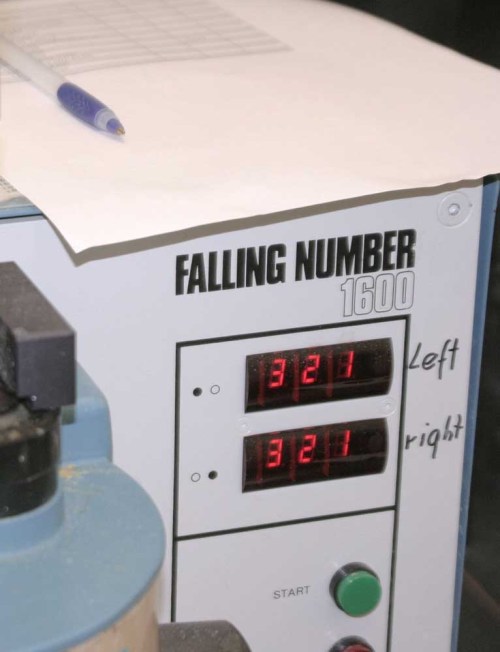Some Idaho wheat farmers grapple with low falling numbers as harvest ends
Published 9:45 am Monday, October 2, 2023

- A sample of wheat goes through a falling number test for starch damage at the USDA Agricultural Research Service laboratory in Pullman, Wash.
BOISE — Late harvest rains in Idaho have caused sprout damage, resulting in low falling number test results in the last of the wheat to be brought in, the executive director of the state wheat commission says.
“It is geographically widespread in that we’ve seeing reports of low falling number in both the northern and southern part of the state,” Britany Hurst Marchant told the Capital Press. “However, because it happened at the very tail end of harvest, the volume of wheat damaged is quite low.”
Trending
The test
The commonly used falling number test measures starch damage in wheat. Technicians determine how long it takes two pins to fall through a ground wheat-water slurry, measuring its viscosity. Wheat with a low falling number has starch damage and is sold at a discount because it can reduce the quality of baked goods and noodles.
Farmers were caught off guard in 2016 when 44% of soft white wheat samples and 42% of club wheat samples tested below 300, the industry standard. The industry estimated the damage that year cost farmers more than $30 million in lower wheat prices.
Low falling numbers can be caused by pre-harvest sprouting due to rain or by late maturity alpha-amylase occurring as a result of large temperature fluctuations during late grain filling.
The longer the wheat is in the ground, the more risk farmers have of damage from natural occurrences like hail and rain, Hurst Marchant said.
Growing season delayed
Trending
This year, a late spring, cool weather, and extended snow cover held up progress at the front of the growing season, pushing harvest later, she said.
“As a result, the rains we got in the second half of August and in early September fell on wheat that hadn’t been cut yet,” she said. “When the wheat gets too wet and starts to sprout again or you get increased levels of late maturity alpha amylase during grain fill, you end up with low falling number.”
Sprout-damaged wheat goes into the feed markets, as a lower quality wheat, compared to “grade 1” or “grade 2” wheat exported or milled domestically as a high-quality ingredient, Hurst Marchant said.
“The wheat in which we saw sprout damage and low falling number will in no way compromise the quality of wheat customers and consumers are accustomed to receiving from the Pacific Northwest,” she said, in a message to overseas buyers. “We take great care to ensure that the highest quality wheat is what we are feeding our families and your families. The vast majority of our crop this year meets the quality characteristics you expect and upon which you depend from PNW wheat.”
Few options
Farmers with low falling number don’t have many options, she said.
“We blend wheat all the time to get certain protein levels or to meet other specifications required by customers, but you can’t blend out low falling number,” she said.
Some people say anecdotally that leaving wheat in the bin longer will improve results of the test, but there’s no proof or scientific finding to support that theory, she said.
Some farmers have the same load of wheat tested twice, receiving different results. Getting wheat tested more than once is not a bad idea, Hurst Marchant said. The farinograph, which tests starch quality, leaves room for error.
“If your falling number result is lower than you thought it would be, it’s OK to get it tested again,” she said. “But remember, that variability goes both ways and having it tested again may be to your detriment. Testing high moisture grain can also lower your falling number results.”
Oregon, Washington results
Oregon’s wheat harvest was largely complete prior to rains, so exportable crop did not see any falling number issues, said Amanda Hoey, Oregon Wheat CEO.
In Washington, there have been a few instances, but overall wheat quality is “sound,” said Amber Hauvermale, Washington State University research assistant professor.
There was “a lot of really, really good grain and a few isolated incidents where there may be low falling numbers on the farm level,” she said.
New rapid test
The current falling numbers test is slow, can only measure two samples at a time, and requires expensive equipment. Due to expense and logistics, most grain elevators don’t have a falling number testing system on hand, Hauvermale said in a WSU news release.
Q&A: Researchers make progress on new tests for starch quality in wheat
USDA advertises for falling number researcher
WSU and USDA Agricultural Research Service researchers and industry stakeholders are developing a new rapid test.
“We are creating an immunological test for evaluating wheat quality, that will be calibrated to a falling numbers test,” Hauvermale said.
The report will look familiar to wheat industry members, she said, “but the way we’re detecting issues with grain quality is completely different.”
The current falling number test is an “indirect measure” of alpha-amylase. The new test would directly measure the enzyme and its activity, Hauvermale said.
In August, they received a three-year $850,000 grant from the Foundation for Food and Agriculture Research.
Researchers delivered proof of concept of a test to diagnostic technology company EnviroLogix, based in Portland, Maine. The company is in “validation phase,” making tests accessible to the grain industry. They will deliver beta tests during the fall and winter to test grain samples acquired this year, Hauvermale said.
“As we move into spring, we hope to actually be testing in real time at elevators,” she said.









